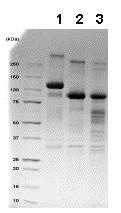Recombinant human GCSF Receptor protein (Fc Chimera) (ab83994)
Key features and details
- Expression system: HEK 293 cells
- Purity: > 95% SDS-PAGE
- Active: Yes
- Suitable for: SDS-PAGE, Functional Studies
-
Product name
Recombinant human GCSF Receptor protein (Fc Chimera)
See all GCSF Receptor proteins and peptides -
Biological activity
The ED50 of ab83994 is typically 2-3 ng/ml as measured by its ability to neutralize GCSF mediated proliferation of the murine myeloblastic m-NFS-60 cell line. -
Purity
> 95 % SDS-PAGE. -
Expression system
HEK 293 cells -
Accession
-
Protein length
Protein fragment -
Animal free
No -
Nature
Recombinant -
-
Species
Human -
Sequence
Theoretical Sequence: ECGHISVSAPIVHLGDPITASCIIKQNCSHLDPEPQILWRLGAELQPG GRQQRLSDGTQESIITLPHLNHTQAFLSCCLNWGNSLQILDQVELRAG YPPAIPHNLSCLMNLTTSSLICQWEPGPETHLPTSFTLKSFKSRGNCQ TQGDSILDCVPKDGQSHCCIPRKHLLLYQNMGIWVQAENALGTSMSPQ LCLDPMDVVKLEPPMLRTMDPSPEAAPPQAGCLQLCWEPWQPGLHINQ KCELRHKPQRGEASWALVGPLPLEALQYELCGLLPATAYTLQIRCIRW PLPGHWSDWSPSLELRTTERAPTVRLDTWWRQRQLDPRTVQLFWKPVP LEEDSGRIQGYVVSWRPSGQAGAILPLCNTTELSCTFHLPSEAQEVAL VAYNSAGTSRPTPVVFSESRGPALTRLHAMARDPHSLWVGWEPPNPWP QGYVIEWGLGPPSASNSNKTWRMEQNGRATGFLLKENIRPFQLYEIIV TPLYQDTMGPSQHVYAYSQEMAPSHAPELHLKHIGKTWAQLEWVPEPP ELGKSPLTHYTIFWTNAQNQSFSAILNASSRGFVLHGLEPASLYHIHL MAASQAGATNSTVLTLMTLTPRSSNTKVDKKVEPKSCDKTHTCPPCPA PELLGGPSVFLFPPKPKDTLMISRTPEVTCVVVDVSHEDPEVKFNWYV DGVEVHNAKTKPREEQYNSTYRVVSVLTVLHQDWLNGKEYKCKVSNKA LPAPIEKTISKAKGQPREPQVYTLPPSRDELTKNQVSLTCLVKGFYPS DIAVEWESNGQPENNYKTTPPVLDSDGSFFLYSKLTVDKSRWQQGNVF SCSVMHEALHNHYTQKSLSLSPGK -
Amino acids
25 to 621 -
Additional sequence information
Encodes the signal peptide and extracellular domain of human G-CSF R (aa 1-621) was fused to the Fc region of human IgG1 (aa 90-330). The chimeric protein was expressed in modified human 293 cells.
-
Preparation and Storage
-
Alternative names
- CD 114
- CD114
- CD114 antigen
see all -
Function
Receptor for granulocyte colony-stimulating factor (CSF3), essential for granulocytic maturation. Plays a crucial role in the proliferation, differientation and survival of cells along the neutrophilic lineage. In addition it may function in some adhesion or recognition events at the cell surface. -
Tissue specificity
One or several isoforms have been found in myelogenous leukemia cell line KG-1, leukemia U-937 cell line, in bone marrow cells, placenta, and peripheral blood granulocytes. Isoform GCSFR-2 is found only in leukemia U-937 cells. Isoform GCSFR-3 is highly expressed in placenta. -
Involvement in disease
Hereditary neutrophilia -
Sequence similarities
Belongs to the type I cytokine receptor family. Type 2 subfamily.
Contains 5 fibronectin type-III domains.
Contains 1 Ig-like C2-type (immunoglobulin-like) domain. -
Domain
The WSXWS motif appears to be necessary for proper protein folding and thereby efficient intracellular transport and cell-surface receptor binding.
The box 1 motif is required for JAK interaction and/or activation. -
Cellular localization
Secreted and Cell membrane. - Information by UniProt
Images
-
1D SDS-PAGE of ab83994 before and after treatment with glycosidases to remove oligosaccharides.
Lane 1: ab83994
Lane 2: ab83994 treated with PNGase F to remove potential N-linked glycans
Lane 3: ab83994 treated with a glycosidase cocktail to remove potential N- and O-linked glycans.
Approximately 5 μg of protein was loaded per lane; Gel was stained using Coomassie. Drop in MW after treatment with PNGase F indicates presence of N-linked glycans. A tightening of the band after treatment with the glycosidase cocktail indicates that O-linked glycans may be present. Additional bands in lane 2 and lane 3 are glycosidase enzymes.







